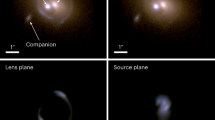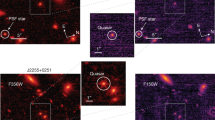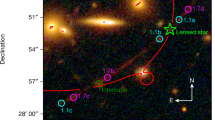Abstract
GRAVITATIONAL lensing can be used to derive fundamental cosmo-logical parameters, provided that the redshift of the lens and the structure of its potential well are known1. The radio source PKS1830–211—a lensed quasar2–5 whose components are separated by about 1 arcsecond—is ideal for such an examination, but until recently the redshift of the lens has been unknown. Here we report the detection and identification of 12 molecular absorption lines in the spectrum of PKS1830–211; the lines originate in the lensing source, which is probably a spiral galaxy, at a redshift of ~0.89. Only one of the lensed components is covered by the intervening molecular gas; when combined with the strong variability in the quasar, this creates a unique opportunity to measure the difference in the light travel time for the two components, which depends in part on the Hubble constant and the cosmic deceleration parameter.
This is a preview of subscription content, access via your institution
Access options
Subscribe to this journal
Receive 51 print issues and online access
$199.00 per year
only $3.90 per issue
Buy this article
- Purchase on Springer Link
- Instant access to full article PDF
Prices may be subject to local taxes which are calculated during checkout
Similar content being viewed by others
References
Narayan, R. Astrophys. J. 378, L5–L9 (1991).
Subrahmanyan, R., Narasimha, D., Rao, A. P. & Swarup, G. Mon. Not. R. astr. Soc. 246, 263–272 (1990).
Jauncey, D. L. et al. Nature 352, 132–134 (1991).
Nair, S., Narashima, D. & Rao, A. P. Astrophys. J. 407, 46–59 (1993).
Kochanek, C. S. & Narayan, R. Astrophys. J. 401, 461–473 (1992).
Djorgovski, S. et al. Mon. Not. R. astr. Soc. 257, 240–244 (1992).
McMahon, P. M., Moore, C., Hewitt, J. N., Rupen, M. P. & Carilli, C. Bull. Am. astr. Soc. 25, 1307 (1993).
Wiklind, T. & Combes, F. Astr. Astrophys. 286, L9–L12 (1994).
Wiklind, T. & Combes, F. Astr. Astropnys. 299, 382–388 (1995).
Wiklind, T. & Combes, F. Astr. Astrophys. (submitted).
Steppe, H. et al. Astr. Astrophys. Suppl. Ser. 102, 611–635 (1993).
Wiklind, T., Combes, F. & Henkel, C. Astr. Astrophys. 297, 643–659 (1995).
Author information
Authors and Affiliations
Rights and permissions
About this article
Cite this article
Wiklind, T., Combes, F. The redshift of the gravitational lens of PKS1830–211 determined from molecular absorption lines. Nature 379, 139–141 (1996). https://doi.org/10.1038/379139a0
Received:
Accepted:
Issue Date:
DOI: https://doi.org/10.1038/379139a0
This article is cited by
-
Central engine of a gamma-ray blazar resolved through the magnifying glass of gravitational microlensing
Nature Physics (2015)
-
Molecular absorptions in high-z objects
Astrophysics and Space Science (2008)
-
Gravitational lensing by spiral galaxies
Pramana (1999)
Comments
By submitting a comment you agree to abide by our Terms and Community Guidelines. If you find something abusive or that does not comply with our terms or guidelines please flag it as inappropriate.



